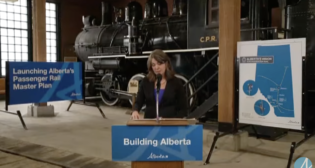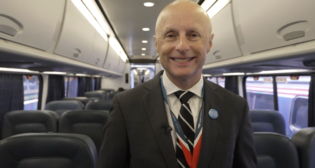
Blame aplenty for high speed rail woes
Written by Frank N. Wilner, Capitol Hill Contributing EditorDon’t assume, based on headlines, an obituary for high speed rail just yet. A more accurate analogy is an induced coma brought on by poor planning and implementation amidst an increased necessity to pare federal deficits.
Contrary to popular opinion, the setback for high speed rail is not entirely the skivvy of budget-cutting-obsessed Republicans. The Obama Administration’s management of previously appropriated high speed rail funding has been as clumsy as its superintending of the Affordable Care Act’s rollout.
How America has regressed from the brief halcyon dawn of high speed passenger rail to its seeming current twilight is mostly a tale of political wretchedness.
It wasn’t so long ago — 2009, actually — when Democrats controlled both chambers of Congress, that lawmakers approved, as part of the American Recovery and Reinvestment Act (ARRA), $8 billion for high speed rail projects. The House passed the measure 246-183, with all “yes” votes coming from Democrats. In the Senate, the bill passed 60-38, with only three Republicans voting “yes.”
Glory days for high speed passenger rail in America appeared to have arrived. Indeed, in 2011, President Obama voiced, in his State of the Union speech, a vision that 80% of Americans would have access to high speed passenger rail within 25 years. He proposed, on top of the $8 billion appropriated for high speed rail in 2009, another $53 billion over six years.
But budget-cutting Republicans had by then gained control of the House, and high speed rail fortunes began a deep dive south that hit bottom last week with passage by Congress of a $1.1 trillion omnibus spending bill (for the remainder of Fiscal Year 2014, which ends Oct. 1) that zeroed out any future spending on high speed rail. The reason extends beyond budget-cutting objectives.
Consider, for example, that the omnibus spending bill provides an increase in spending on Amtrak ($1.39 billion, a $46 million boost over its previous appropriation), and a $600 million appropriation to extend Transportation Investment Generating Economic Recovery (TIGER) grants, some of which will be available for passenger rail projects.
Whether more skillful handling by the Obama Administration of ARRA appropriations might have tempted Republican fellow-travelers to the future of high speed rail is indeterminate. That Republicans have adopted a more conciliatory approach to infrastructure funding, as evidenced by passage of the omnibus spending bill last week, is suggestive.
Former Urban Mass Transit Administration Associate Administrator Ken Orski, now a consultant and publisher of Innovation News Briefs, was instructive in his recent congressional testimony:
“The Administration’s first misstep, in my judgment, has been to misleadingly represent its program as ‘high speed rail,’ thus conjuring up an image of bullet trains cruising at 200 mph, just as they do in Western Europe and the Far East. It further raised false expectation by claiming that ‘within 25 years, 80% of Americans will have access to high speed rail.’ In reality, the Administration’s high speed rail program will do no such thing … with one exception, the program consists of a collection of planning, engineering, and construction grants that seek incremental improvements in the existing facilities of Class I freight railroads, in selected corridors used by Amtrak trains.
“While some of the projects funded with high speed rail dollars may result in modest increases of speed, frequency, and reliability of Amtrak services, none of the awards, except for the California grant, will lead to construction of new railbeds in dedicated rights-of-way. As any railroad operator will tell you, dedicated track, reserved exclusively for passenger trains, is essential to the operation of true high speed rail service — such as the service offered by the French TGV, the German ICE, and the Japanese Shinkansen trains, that run at top speeds of 200 mph and higher.
“For example, while a $1.1 billion program of track upgrades between Chicago and St. Louis [over Union Pacific-owned track] will enable Amtrak trains to increase top speeds to 110 mph, average speeds between these two cities — slowed by the need of Amtrak trains to share track with freight traffic — will rise only 10 mph, from 53 to 63 mph.”
Slate magazine was equally disparaging:
“Rather than focus on a few corridors that need high speed lines the most, the Obama Administration doled out half-a-billion here and half-a-billion there [145 projects in 32 states], a strategy better suited to currying political support than addressing real infrastructure projects.”
The rejection of ARRA high speed rail grants by the states of Florida, Ohio and Wisconsin — albeit by Republican governors — was premised on a conclusion that the federal funds for high speed rail were distressingly insignificant to deliver what was promised. Cited was the inability of those states to find adequate additional funding to move beyond engineering and environmental reports and actually put people to work building high speed rail.
Most interesting is that the Obama Administration’s doling out of ARRA funds initially ignored the single shovel-ready high speed rail project — Amtrak’s Northeast Corridor. Former House Transportation & Infrastructure Committee Chairman John Mica (R-Fla.), no fan of Amtrak or even high speed rail in his own state, was among the first to criticize this omission, submitting strongly that Republican support actually exists for a shovel-ready high speed rail project that could demonstrably be completed.
Mica wasn’t playing politics, because there are scant Republican majorities along the Northeast Corridor; but California, for sure, is a political-party battleground, and that is where the Obama Administration directed the bulk of its ARRA funding. If high speed rail in America is now in an induced coma, the California project is on life support.
Some history is in order. California voters in 2008 approved a $10 billion bond issue to help fund a $98 billion high speed rail project linking San Francisco and Los Angeles — and perhaps as far south as San Diego. The Obama Administration earmarked $3.2 billion in ARRA funds for that project (including portions of ARRA funds rejected by Florida, Ohio, and Wisconsin).
Rather than begin the project between two highly populated areas, which arguably would have bolstered public support, a decision was made — allegedly at the insistence of the Obama Administration and against recommendations of senior California legislative staff — to begin construction in the sparsely populated Central Valley between Merced and Bakersfield. Woe is the aftermath.
Recently, a California court denied the California High Speed Rail Authority access to the bond funds because of failure by the state to comply with requirements. The Surface Transportation Board denied the Authority’s request for an early conditional construction approval prior to completion of environmental review, and voter polls show waning public support (43% today vs. 53% in 2008) for the project, owing to cost estimates that escalated, a completion date that was extended, trip times that were revised to be longer, and reportedly higher than realistic ridership projections.
Add to this growing Congressional opposition. House Rail Subcommittee Chairman Jeff Denham (R-Calif.) and House Transportation Appropriations Subcommittee Chairman Tom Latham (R-Ia.) directed the General Accountability Office to review the ARRA grant in light of the court ruling and the Obama Administration’s amendment of prior agreements that allow spending federal funds before state matching funds are released.
Denham also introduced legislation to block spending of federal funds until the court releases the bond money. Co-sponsors include fellow House Republicans from California – Majority Whip Kevin McCarthy, Armed Services Committee Chairman Buck McKeon, and House Oversight Committee Chairman Darrell Issa.
An unpleasant sideshow surfaced when Federal Railroad Administrator Joseph Szabo sent his deputy, Karen Hedlund, to testify at a field hearing chaired by Denham. Denham told Politico he had rescheduled the hearing to accommodate Szabo’s schedule.
Whether the California project can be revived may well depend on a new ballot measure that could be put before California voters in November — and with voter polls showing increasing disenchantment, the future for that project is problematic beyond what transpires before the court and the completion of environmental studies.
That returns us to the shovel-ready Northeast Corridor and its aging infrastructure — tunnels dating to the late 19th and early 20th centuries, and catenary dating to the 1930s, for which reconstruction funds have not been appropriated.
Yet Amtrak’s vision for 220-mph service between Washington, D.C., and Boston — cutting Washington-New York travel time to 96 minutes and New York-Boston trip time to 84 minutes — carries a whopping $117 billion price tag over 30 years.
As reported in a previous blog, the cost of Amtrak’s vision equates to $1 billion per minute saved, and current Acela Express service, averaging 85 mph between Washington and New York with intermediate stops, hasn’t discouraged a growing ridership, with Amtrak’s air/rail market share between Washington and New York an impressive 70%.
A Democratic controlled Congress — not envisioned by serious pundits come November elections — could restore a more broad vision for high speed rail in America. Perhaps the last best chance — directing ARRA funding to the Northeast Corridor — was rejected by the Obama Administration. What is necessary to revive such support in a Congress, given expected continued Republican control of the House and continued pressure to reduce federal spending, cannot be predicted.
What can be said with certainty is that the current Amtrak annual appropriation is insufficient even to bring the Northeast Corridor into a state of good repair — the last major track rehabilitation was undertaken in the 1980s — and there is compelling reason to build new tunnels and catenary for existing service and bring Amtrak closer to airports before embarking on a high speed rail project.
It may be true that in politics, moods and priorities change. But whether the will and wherewithal to fund high speed rail for 80% of the population, or even in the populous California and Northeast corridors, is realistic this year, next year, or the years ahead, is a difficult call.
The Obama Administration, notwithstanding its intentions, has not helped the cause. The induced coma of high speed rail today is as much the fault of a flawed rollout as it is of budget-cutting conservatives, whose numbers in Congress continue to grow.



